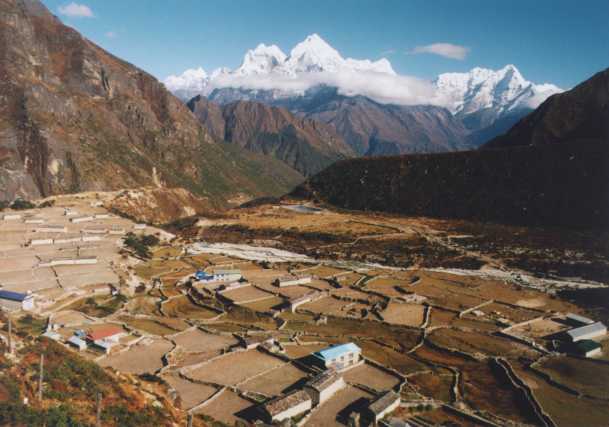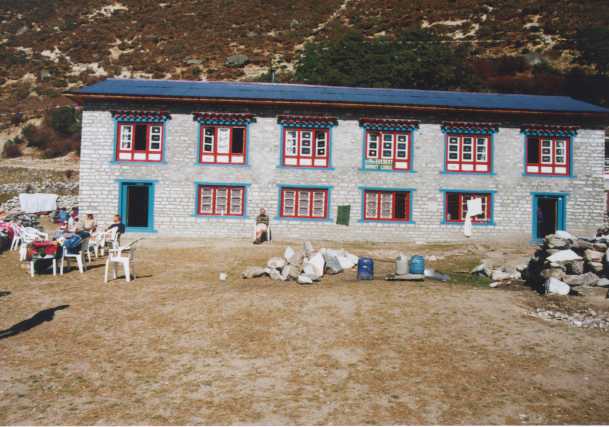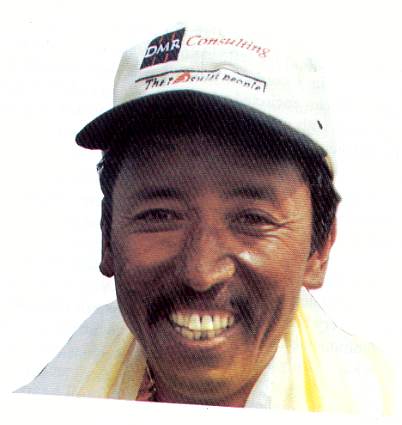Apa Sherpa, 12 times on
Mount Everest

Thame, 3800 m. Mountains of 7000 m in the back ground. View towards Namche
Bazar, to the East. Apa Sherpa’s lodge is on the far left.
Yesterday
we crossed the 5756 m high Trashi Labse pass, from the Rolwaling Valley into
the Everest region. It was my first time here, but I used the directions of the
Australian group leader and the porter that carried my duffle bag a week ago before
switching groups. They came back after taking a sick group member down to Thame
and were still camping on the pass. To
my relieve, they confirmed there was a tea house down at 4300 m. For
four hours we kept on going down without stopping once. This hurry paid off, we
managed to reach the tea house the minute it got pitch dark at 17.45 h.
At 8 PM the
porters finally arrived with our equipment and they were not happy walking in
pitch darkness on a rocky glacier. We celebrated the safe arrival with a dinner
and several bottles of Nepali whisky and this softened them up. That night we
all slept in the only single room around the open fire with 8 persons,
including the teahouse owner with his wife and baby.
Today we
arrived in the first village at 3800 m, in Thame, only 2 hours walking. We
checked into the Himalaya Lodge greeted by Apa Sherpa and his wife and they were
the lodge owners. Apa Sherpa was very friendly but a bit shy like so many
locals and it is difficult to keep the conversation going beyond a few words.
The lodge
is nicely build, with well-built rooms having two single beds each and all
rooms have a view into the valley. Especially his French fries for lunch were
excellent. We definitely entered the comfort of the Everest Region.
That night,
sleeping for the first time in 16 days in a bed and at low altitude, I had a
very deep, long sleep. I woke up after 12 hours with a heavy head and it took
me a while to truly wake up.

Himalaya Lodge of Apa Sherpa
The next
night we met the group of Australians we saw before in Rolwaling and on the
Trashi Labse Pass. They spent 3 nights camping on the Trashi Labse Pass at 5756
m as they tried twice to get up
Parchamo Peak (6200 m) and felt pretty miserable. This was suppose to be
the trip of a life time and a very expensive trip but only their group leader,
a paid mountain guide, had experience in climbing a 3000+ m mountain before. A
man in his fifties from Perth said he got this trip as a present from his son
but started to wonder if the son wasn't after his inheritance. He gave me his card an invited me on his ranch, some
500 km outside Perth.
In the
lodge I noticed a plague with the picture of our lodge owner and a text that he
ascended Mount Everest 11 times. I complimented him on his achievement, not
realizing this was a world record. He responded that he would go again in May 2001 with an American
expedition. He needed the money as he wanted to expand the lodge with an inside
toilet and shower and this was expensive. The current toilet was an outhouse at
a distance from the house and not very comfortable to go to in the middle of
the night.
Will he
survive the 12th attempt? Everest is difficult and many excellent climbers get
caught in avalanches for which there is no defense. I also wonder why there are
so few books written on Sherpa climbers.
An exception is Tenzing Norgay Sherpa who was the climbing partner of
Hillary. They simultaneously reached the top of Mount Everest in 1953, Hillary
leading by possible 10 m joined by a climbing rope so they both should be
quoted, not just Hillary as is done now on most maps.
The Sherpa
version of the climbing stories is often so much different, less heroic and
more realistic. E.g. it is well know among the Sherpas that if you spent one
night on the South Col (8000 m) of Mount Everest, you will have orientation
problems for a few months back home caused by brain damage. They do the heavy
carrying of equipment to the South Col including the heavy oxygen bottles but
only the customers get to use the oxygen at this elevation.
I suggested
to him he should get a ghost writer, similar to Tenzing Norgay. This book has a
very different outlook on mountain climbing. It deals in the first place his life,
in a story telling way of ancient cultures, focused on personal experiences and
dilemmas and interaction with people. The macho adventures you find in Western
books are secondary. Here I do agree, this is what life is all about.
Two years
later in Katmandu, I went to the best stocked book store of Katmandu, the
Pilgrim Book Store, and ask for books on Sherpas. I found only four titles. The
original book on Tenzing Norgay from the fifties has a price tag of over 300
dollars. The book “Nepalese climbers on Mount Everest” has a few pages on Apa
Sherpa.
Epilogue
In April
2003, at the lodge of a grandson of Tenzing Norgay in Namche Bazar, Tashi
Wangchuk Tenzing, a friend saw a
documentary on video of the spring 2002 Swiss expedition to Mount Everest.
This
expedition celebrated that 50 years ago, in the spring of 1952, Raymon Lambert and Tenzing Norgay
almost made it. They reached 28250 feet (8610 m) of the 8848 m and found the
easiest route to the top, using the South Col. The next year this was used by
Hillary and Tenzing Norgay and the 1952 expedition laid the foundation for their
success.
In this expedition,
Apa Sherpa was also a Climbing Sherpa and summited for the 12th time,
together with the grandson. He is thinking of going for the 13th time
in 2003.

Apa Sherpa, picture from the book "Nepalese climbers on Mount
Everest".
References
James
Ramsey Ullman. Man of Everest. The Autobiography
of Tenzing. First published 1955. E
dition published by The Reprint Society London.
Ang Phurba
Sherpa and Ramesh Raj Kunwar. 2002. Nepalese climbers on Mount Everest.
Published by Pemba Chhamji Sherpa, Katmandu. ISBN 99933-756-0-8.
Judy & Tashi
Tenzing. 2002. Tenzing and the Sherpas of Everest. HarperCollins Publishers
India. ISBN 07322 6725 0.
Sherry B.
Ortner. Life and death on Mt. Everest. Oxford University Press, New Delhi. ISBN
019 565 895 7.